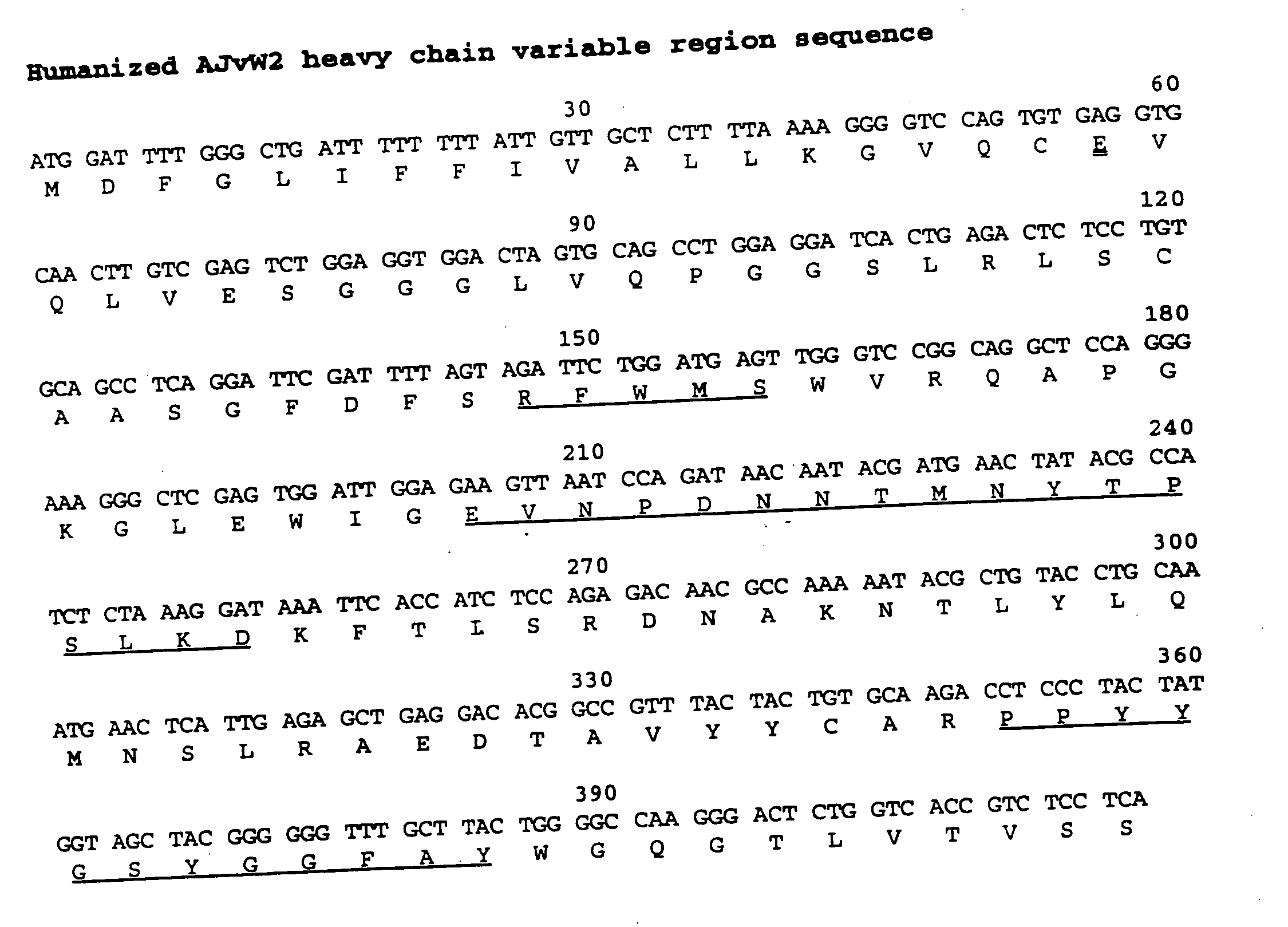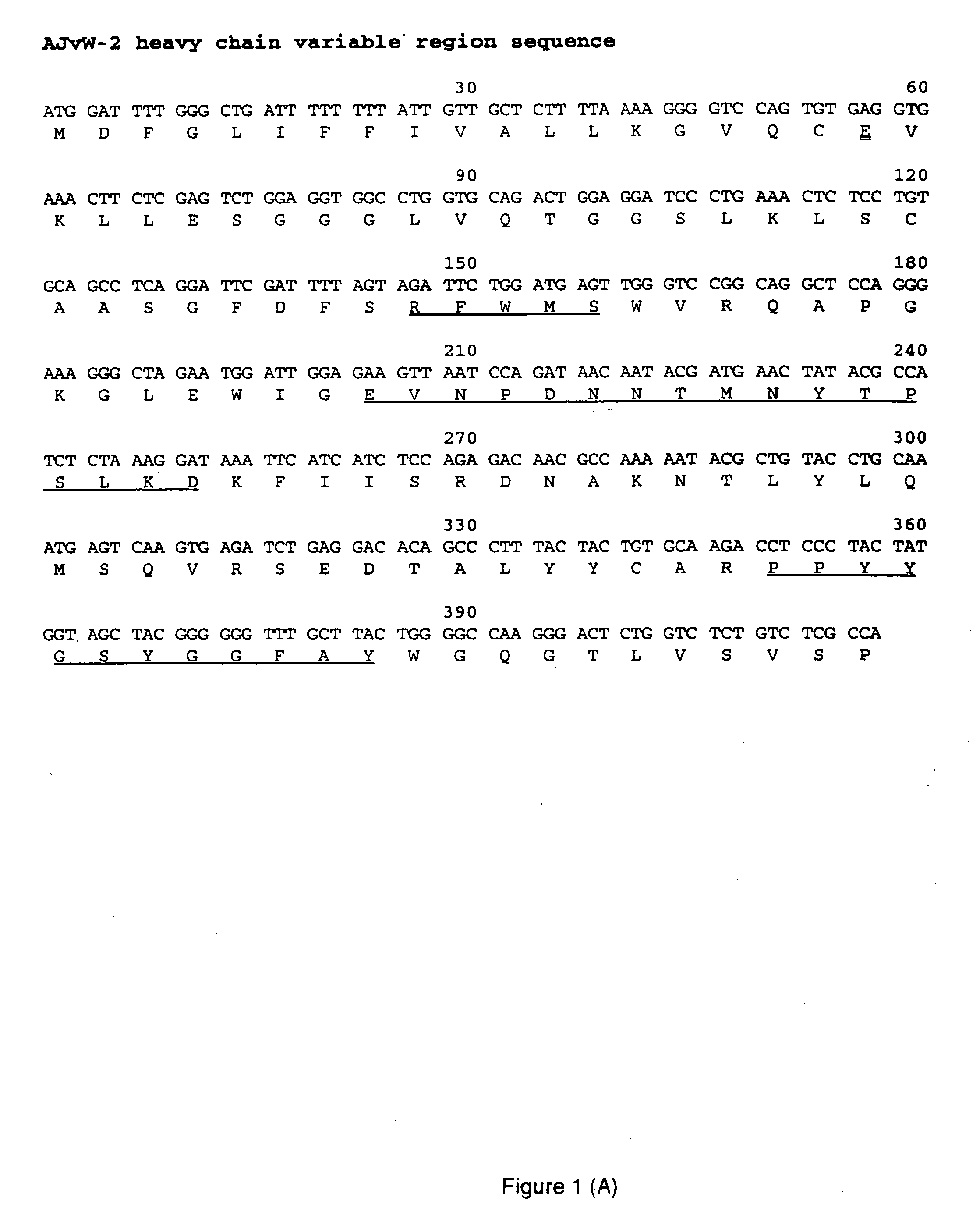Methods of treating thrombotic diseases with von willebrand factor specific antibodies
a technology of von willebrand factor and specific antibodies, which is applied in the field of treating thrombotic diseases with von willebrand factor specific antibodies, can solve the problems of low thrombosis specificity, hemorrhaging as a side effect, and many conventional antithrombotic agents that have low clinical efficacy in clinical applications
- Summary
- Abstract
- Description
- Claims
- Application Information
AI Technical Summary
Problems solved by technology
Method used
Image
Examples
example 1
Cloning and Sequencing of Mouse AJvW-2 Variable Region cDNAs
[0059] Mouse AJvW-2 heavy and light chain variable region cDNAs were cloned from mRNA isolated from hybridoma cells using anchored PCR (Co et al., J Immunol. 148: 1149 (1992)). The 5′ primers that were used annealed to poly-dG tails added to the cDNA, and the 3′ primers to the constant regions. The amplified gene fragments were then inserted into the plasmid pUC18. Nucleotide sequences were determined from several independent clones for both VL and VH cDNA. For the heavy chain, a single, unique sequence was identified, typical of a mouse heavy chain variable region. For the light chain, two unique sequences, both homologous to murine light chain variable region sequences, were identified. However, one sequence was not functional because of a missing nucleotide that caused a frame shift at the V-J junction, and was identified as the non-productive allele. The other sequence was typical of a functional mouse kappa chain vari...
example 2
Design of Humanized AJvW-2 Variable Regions
[0060] To retain the binding affinity of the mouse antibody in the humanized antibody, the general procedures of Queen et al. were followed (Queen et al. Proc. Natl. Acad. Sci. USA 86: 10029 (1989) and U.S. Pat. Nos. 5,585,089 and 5,693,762). The choice of framework residues can be critical in retaining high binding affinity. In principle, a framework sequence from any human antibody can serve as the template for CDR grafting; however, it has been demonstrated that straight CDR replacement into such a framework can lead to significant loss of binding affinity to the antigen (Tempest et al., Biotechnology 9: 266 (1992); Shalaby et al., J. Exp. Med. 17: 217 (1992)). The more homologous a human antibody is to the original murine antibody, the less likely will the human framework introduce distortions into the mouse CDRs that could reduce affinity. Based on a sequence homology search against the Kabat database (Kabat et al., Sequences of Prote...
example 3
Construction of Humanized AJvW-2
[0065] Once the humanized variable region amino acid sequences had been designed as described above, genes were constructed to encode them, including signal peptides, splice donor signals and appropriate restriction sites (FIG. 2). The light and heavy chain variable region genes were constructed and amplified using eight overlapping synthetic oligonucleotides ranging in length from approximately 65 to 80 bases (see He et al. J. Immunol. 160: 1029 (1998)). The oligos were annealed pairwise and extended with the Klenow fragment of DNA polymerase I, yielding four double-stranded fragments. The resulting fragments were denatured, annealed, and extended with Klenow, yielding two fragments. These fragments were denatured, annealed pairwise, and extended once again, yielding a full-length gene. The resulting product was amplified by polymerase chain reaction (PCR) using Taq polymerase, gel-purified, digested with XbaI, gel-purified again, and subcloned into...
PUM
| Property | Measurement | Unit |
|---|---|---|
| Fraction | aaaaa | aaaaa |
Abstract
Description
Claims
Application Information
 Login to View More
Login to View More - R&D
- Intellectual Property
- Life Sciences
- Materials
- Tech Scout
- Unparalleled Data Quality
- Higher Quality Content
- 60% Fewer Hallucinations
Browse by: Latest US Patents, China's latest patents, Technical Efficacy Thesaurus, Application Domain, Technology Topic, Popular Technical Reports.
© 2025 PatSnap. All rights reserved.Legal|Privacy policy|Modern Slavery Act Transparency Statement|Sitemap|About US| Contact US: help@patsnap.com



